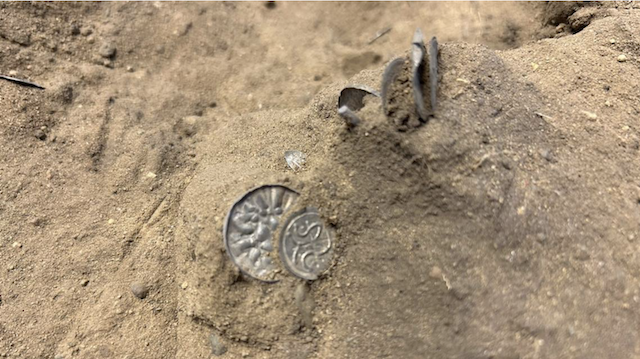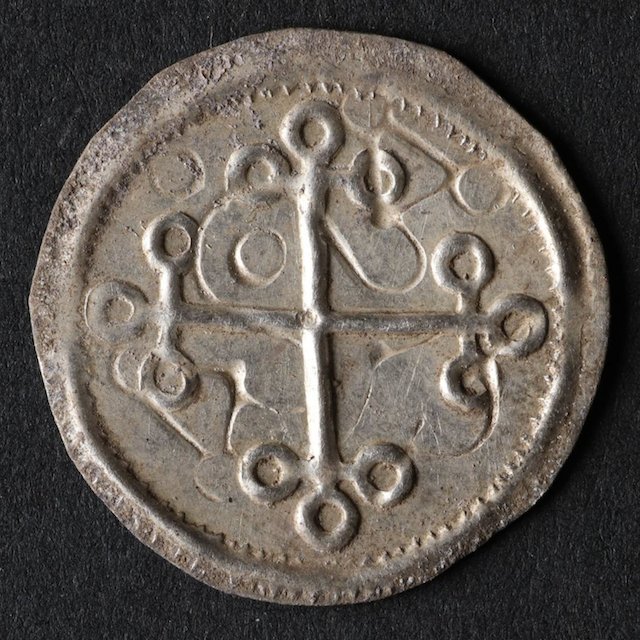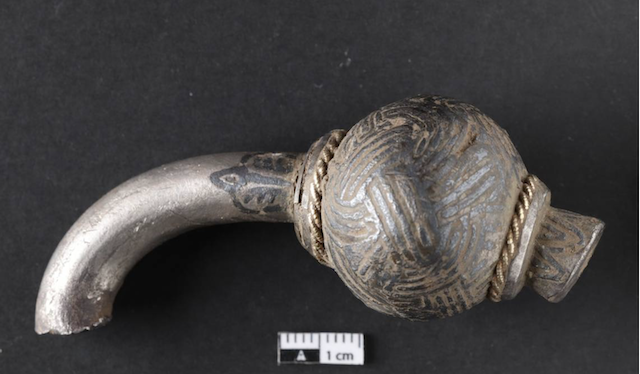
Woman in Bramslev stumbled on hundreds of 1,000-year-old silver coins in two buried treasure troves, archaeologists said and photos show. Photo from North Jutland Museums
Perhaps carefully planning ahead or rushed in a moment of panic, someone in Viking-age Denmark buried their treasure and never returned. A volunteer stumbled upon the artifacts 1,000 years later.
Jane Foged-Mønster went out with a metal detecting group to search a field in northern Denmark last fall, she told TV2 Nord, a local Danish outlet. Scanning the field, she unearthed a piece of silver. Nearby, she found several more pieces, the outlet reported on April 19.
The volunteers quickly alerted local archaeological authorities who began excavating the site in Bramslev, the North Jutland Museums said in a news release.
Archaeologists uncovered two Viking-era treasure troves buried around the same time and within 165 feet of each other, the release said. Because of agricultural plowing, archaeologists found the artifacts scattered widely across the area and could not definitely identify which artifacts came from which treasure trove.
Together, the treasure troves contained about 300 silver coins dating to the 980s A.D., the release said. Archaeologists found a mixture of Danish, German and Arab coins as well as a type of cross coin made when King Harald “Bluetooth” Blåtand ruled the region.
Photos show this type of cross coin that had a plus-sign-shaped design with three circles on each point. The coin appears a bit scratched and worn.
The cross coins from King Bluetooth, as he’s most commonly known in English, were only circulated for a few decades before the king’s son took the throne in the mid-980s, North Jutland Museums said in an April 20 post on Instagram.

One of the Viking cross coins from the buried treasure troves. Photo from North Jutland Museums
The 1,000-year-old treasure troves also contained several chopped up pieces of silver jewelry, the release said. These fragmented adornments were likely part of a payment-by-weight system.
Archaeologists identified two pieces of the same jewelry item: an unusually large and elaborate silver ring pin. Photos show the fragment with an intricately braided ball on the end of a curved rod. A rope-like ring and smaller decorative designs frame the central orb.
This ring pin came from Vikings in Ireland or nearby islands and was likely worn by a king or high-ranking religious authority, experts said. The ring pin was probably stolen during a raiding expedition and brought back to Denmark.
Danish Vikings did not wear this type of ring pin, so the stolen goods were chopped up for use as currency or melted down and remade into the local jewelry style, the release said.

Part of a silver ring pin from Viking-age Ireland or another nearby island. Photo from North Jutland Museums
“A hoard like this is very rare,” the director of the North Jutland Museum, Lars Christian Norbach, told AFP.
The significance of the treasure troves partially stems from the area where they were found, the release said. The artifacts were found at a Viking settlement about 5 miles from Fyrkat, a Viking castle fortress built by King Bluetooth.
The Fyrkat castle was unexplainably abandoned about the same time or soon after the silver treasures were buried, Torben Trier Christiansen, an archaeologist with the North Jutland Museums, said in the release.
The buried treasure, the abandoned castle and the showdown between King Bluetooth and his son may all be connected, Christiansen said. Unrest or fear of impending violence may have prompted people living at the Bramslev settlement to hide their valuables, he said in the release.
To investigate this possibility and understand more about the area’s Viking history, archaeologists will continue excavating the Bramslev settlement this fall, the release said. They don’t expect to find more silver treasures, but they hope to identify ruins of settlement buildings.
The silver treasures will go on display at a North Jutland Museum beginning in July, the release said.
Bramslev is located in the eastern peninsula region of Jutland and about 170 miles northwest of Copenhagen.
Written by Aspen Pflughoeft for the Miami Herald ~ April 21, 2023








